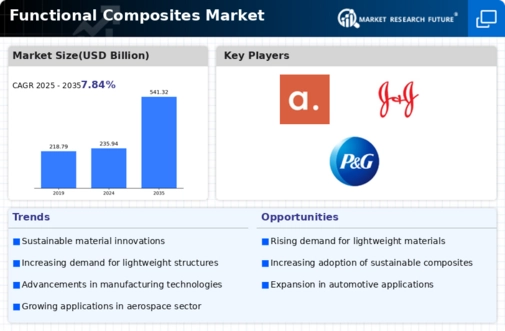Market Share
Functional Composites Market Share Analysis
In the realm of the Functional Composites Market, positioning strategies play a pivotal role in determining the success and sustainability of businesses. Market share positioning strategies are fundamental tactics employed by companies to carve out their niche and establish a competitive edge within the market landscape. These strategies encompass a range of approaches aimed at capturing and retaining a significant portion of the market share.
The growing demand for functional composites in eco-friendly constructions is attributing to the growth of the segment. The thermal conductive functional composites improve the energy efficiency in heating, air conditioning, ventilation, and lighting applications. On the basis of the type, polymer matrix composites are the leading segment and are expected to exhibit an exponential CAGR during the forecast years.
One common market share positioning strategy utilized by companies operating in the Functional Composites Market is differentiation. By focusing on unique product features, innovative technologies, or specialized applications, businesses can differentiate their offerings from competitors. For instance, companies may develop composites with enhanced durability, superior performance characteristics, or specific functionalities tailored to meet the needs of niche markets. Through effective differentiation, companies can attract customers seeking distinct advantages, thereby solidifying their market share.
Another essential strategy in market share positioning is cost leadership. In this approach, companies strive to become the lowest-cost producer within the market segment while maintaining acceptable quality standards. Cost leadership strategies involve streamlining production processes, optimizing supply chain operations, and leveraging economies of scale to drive down manufacturing costs. By offering competitive pricing without compromising quality, companies can appeal to price-sensitive customers and capture a significant share of the market.
Furthermore, product specialization is a strategic avenue pursued by companies aiming to dominate specific segments of the Functional Composites Market. Rather than offering a broad range of composite materials, companies may focus on developing expertise in particular applications or industries. For example, a company might specialize in composites designed for aerospace components, automotive parts, or renewable energy infrastructure. By concentrating resources and research efforts on a specialized niche, companies can position themselves as leaders in that particular segment, thereby increasing their market share and brand recognition.
Strategic alliances and partnerships also play a crucial role in market share positioning within the Functional Composites Market. Collaborating with suppliers, distributors, or research institutions enables companies to access complementary resources, expertise, and distribution channels. Joint ventures, licensing agreements, and strategic acquisitions can provide companies with the necessary capabilities to expand their market presence and gain a competitive advantage. Through strategic partnerships, companies can leverage shared strengths and mitigate weaknesses, ultimately enhancing their market share positioning.
Moreover, effective marketing and branding strategies are instrumental in shaping perceptions and influencing purchasing decisions in the Functional Composites Market. Building a strong brand identity, communicating value propositions, and engaging target audiences through targeted marketing campaigns are essential components of successful market share positioning. Companies often invest in branding initiatives that emphasize product attributes, performance benefits, and brand values to differentiate themselves and capture the attention of customers.
Additionally, continuous innovation and research and development (R&D) efforts are critical for maintaining a competitive edge and sustaining market share in the Functional Composites Market. By investing in R&D, companies can develop cutting-edge technologies, explore new applications, and stay ahead of emerging trends in materials science and engineering. Innovation allows companies to introduce novel products and solutions that address evolving customer needs and preferences, thereby solidifying their position in the market.






Leave a Comment